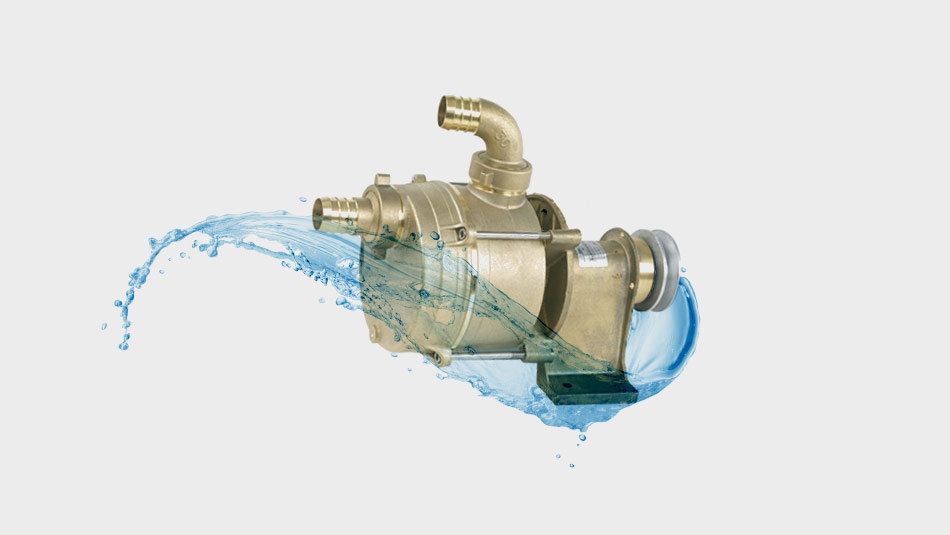What are the advantages of pulley pumps?

Everything you need to know about the advantages of pulley pumps
They are used to transfer water, diesel fuel or seawater.
Whether for the agriculture, marine, industry or automobile sector, pulley pumps stand out for their simple and robust mechanism. An overview of this system, its operation and its many advantages!
Need advice?
Our team of experts is here to help you.
You can contact us via a simple click:
The operating principle of pulley pumps
They consist of a pump body with an external alloy pulley, which is generally linked by a belt to a pre-installed motor, an impeller to enable the liquid to circulate, a rotary seal, a shaft and one or two bearings.
Seals prevent any risk of leakage during the transfer of liquids.
The principle is simple. When the motor rotates, it drives the belt and thus the pulley, which activates the pump mechanism.
In fact, it is the pulley that transfers the kinetic energy to the pump that is necessary to operate it. The belt transfers its movement to the pulley. This gathers speed and thus primes the pump. It operates on the principle of the rotodynamic or centrifugal pump.
Thus, the main particularity of this hydraulic system is that it does not require an electric system to operate.
Uses of pulley pumps
They come in a wide range of models for different uses: centrifugal pumps, flexible impeller pumps, vane pumps, with or without priming tanks, etc.
Pulley pumps are connected to the toothed belts of combustion engines. They are thus found on car, truck and tractor engines.
For marine use, this model is an effective pumping system for vessels that do not have an electric generator on board. They are also used as emergency bilge pumps in case of a power failure.
In the agricultural sector, motor pumps operate on the same mechanism. They can pump water at a high flow rate and at a depth of up to 25 metres to irrigate crops.
Engine-driven water pumps are also used to empty cellars and to discharge well water.
NB: Tractors are equipped with a hydraulic power take-off or PTO that makes it possible to connect directly to the pump body via a splined drive shaft.
They can also be coupled to an electric motor. The advantage of this type of installation is that it is totally independent. It does not depend on the speeds of the engine belts to operate.
Disassembling and repairing water pumps
Regular maintenance is required to ensure their proper operation. The operation is not very complex and does not require a large number of tools.
Certain signs should warn you:
- Abnormal motor noise is often due to a problem with the tension of the drive belt.
- Seal wear may lead to cooling liquid leakage.
Check that the belt is properly tightened. If the pulley is not tight enough, the belt and the pump will wear down very quickly. Use an automatic tensioner to tighten the belt.
If the pulley makes a noise, check the operation of its internal bearings.
If the pump has seized up, it is necessary to start by draining the hydraulic circuit.
Damaged or worn vanes must be replaced.
What are the advantages of pulley pumps?
The first advantage of this type of installation is that it is particularly compact, but pulley pumps have other significant advantages.
An interchangeable installation
A pulley pump has a shaft that is independent from the motor. The belt is the only link between the motor and the pump. The installation does not require mechanical coupling or alignment.
This is a real advantage because it enables them to adapt to any type of motor.
Simple adjustment depending on the liquids to be pumped
Pulley pumps are used to pump not only water and seawater, but also dangerous or viscous products.
The differences in pulley sizes make the use of a gear reducer unnecessary. This is a series of gears that enable the pump to operate at a speed that is different from that of the motor: faster or slower depending on the viscosity or the height of discharge.
To adjust pump performance, flow rate and pressure, simply modify the diameter of the emitting and receiving pulleys, which is more economical than changing pumps.
Some pulley pumps are equipped with an electromagnetic clutch. This is a real advantage for use aboard boats because it enables them to be controlled from a distance.
In this way, for example, it is possible to activate a bilge pump from the helm.
Easier maintenance
The pulley pump mechanism with a transmission belt is independent from the motor on which it is installed. Thus, if the pump has a seal problem, the pumped liquid does not risk leaking and creating damage to the motor parts.
To obtain personalised advice, contact us by telephone on +33 (0)3 81 96 16 47 or via our contact form to inform us of your needs.
